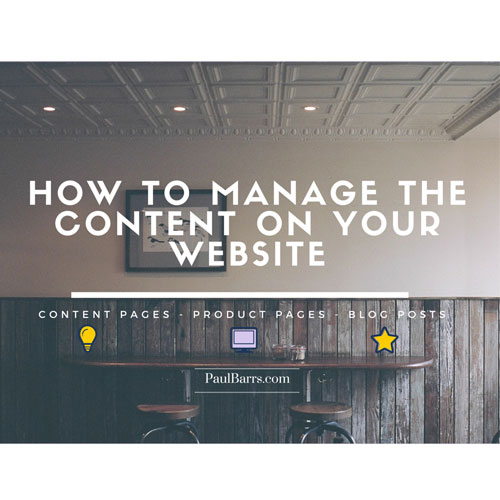
24 Mar How to Manage The Content on Your Website
It’s great to have a Blog, but a Blog is not enough. Your blog should be supporting your primary product content pages. The whole point is to attract traffic and then CONVERT it. This month we’re talking about content and content management, following up from last month where we specialised with things to do with search engine optimisation.
When a client comes to me and says, “Okay, Paul we’ve finished all of our on-page SEO. What do we do now? What’s this content thing?” And really that’s all that they need to be focused on from there on in is their content management, getting it up onto the website, getting it out through social media, getting it out from there into all the different platforms to attract business and the customer back.
So I say to them, “Well, do you remember, all the way back at the beginning, we did the keyword research?” Mm-hmm, yes, they remember that. And I say, “That’s where we find now the foundation for your content management.”
So let me just give you a quick snapshot of how content should be structured on your website and that internal linking system and where we get our ideas for the content from.
First things first, we go back to that keyword research, and we look at this whole list, which can be 20, 30, 50, 80, 100 keywords or more. Those are keyword phrases, of course, that people are actually searching for related to your business, related to your product or service. And within this we found the best opportunities through competitive analysis and narrowed down the hundreds to the short list of 50, 80, or so.
Going through that, what I then suggest — and we’ve done this with our on page optimisation — is we look for topical content, keyword phrases, search phrases, things that people are looking for which are related but individually different. Let’s say we’ve got about half a dozen different search things which are on a particular topic. Now the things themselves are different, but the topic is just one.
So they create and have created a good, solid, strong content conversion page. And this is a page which of course has all the content, it answers the questions, it informs the customer, it shows your expertise, it shows authority that you know what you’re talking about, and build trust with the customer. This is the content page talking about a number of different search things all on one topic. Now we duplicate that three, four, five, half a dozen times or as many as required to talk about the different areas, the different product categories or services within your business.
Then what you do to generate more content is you take the individual search phrase ideas, the concept behind them, and create blog posts. So imagine we’ve got our content pages over here and then our blog posts over here. This page talks about, for example, about half a dozen, we’ve got five different topics. But the blog post will talk about just one, maybe two, and of course link over to here for more information.
Here’s the conversion. The blog post is what helps generate fresh new traffic on an ongoing basis, gets shared through social media, can be replicated through video, and so on, and so on. It generates that traffic, sends them to the conversion.
And then we have another couple of topics over here, and that becomes another blog post, and another topic over here, and that becomes another blog post. And they’re all linking to and supporting this primary content conversion page. And that’s the way to structure content on your website.
Keeping in mind of course, here’s the disclaimer, there are generally two different types of customers — those who already know what they want and they’re just going to go straight there, look at prices, look at options and go, “Bang, I’m going to buy.” They’ve made that buying decision already on the product, service, or type. They don’t necessarily know who they’re going to purchase from perhaps, because they haven’t decided that. You just want to send them straight to your product page. You just want to send them straight to your services page. They know what they want.
But then there’s the other type of customer, the 80% in some industries, and they know what they want. They’re not just quite sure yet about the options, about how it works. “Maybe I should take this. Maybe I should take that.” They’re the ones that we’re looking for to grow our business, people who are not yet already buying from us, even from our product or service. That’s how we increase and how we generate growth.
And these content conversion pages, based on what people are looking for, for information and that’s most of what the web is folks, it’s information, people looking for answers to things. And it’s always been the rule in selling.
If you can answer your prospects’ questions, if you can meet their needs, you will be successful in business.
And a good solid content conversion paced topical, based on many different topics, with blog post supporting it, you get that from your keyword research.
Not just going into the meta title, not just the description, not just your headings, not just your page URLs, but solid content. And that’s the number one place where you should be looking for content ideas, and then it gets through blog posts as I mentioned, through videos, you can do podcasting, you can create documents, you can create SlideShare. All of these different things, all out here, all over the web, they come back and support these topical content pages.
So that’s my idea for you for this week. I’d like you to look at your website, look at your products and services, and look at the topics that you could be talking about. And don’t just talk about them in your blog, create solid content pages. Support them through internal linking with your blog posts. Support them through external linking through your social media, through your videos, audios, and so on. That’s the content strategy.
Next week we’ll talk about where we can find more ideas and thought starters to generate even more content. Have a great week, and I’ll talk to you soon.


